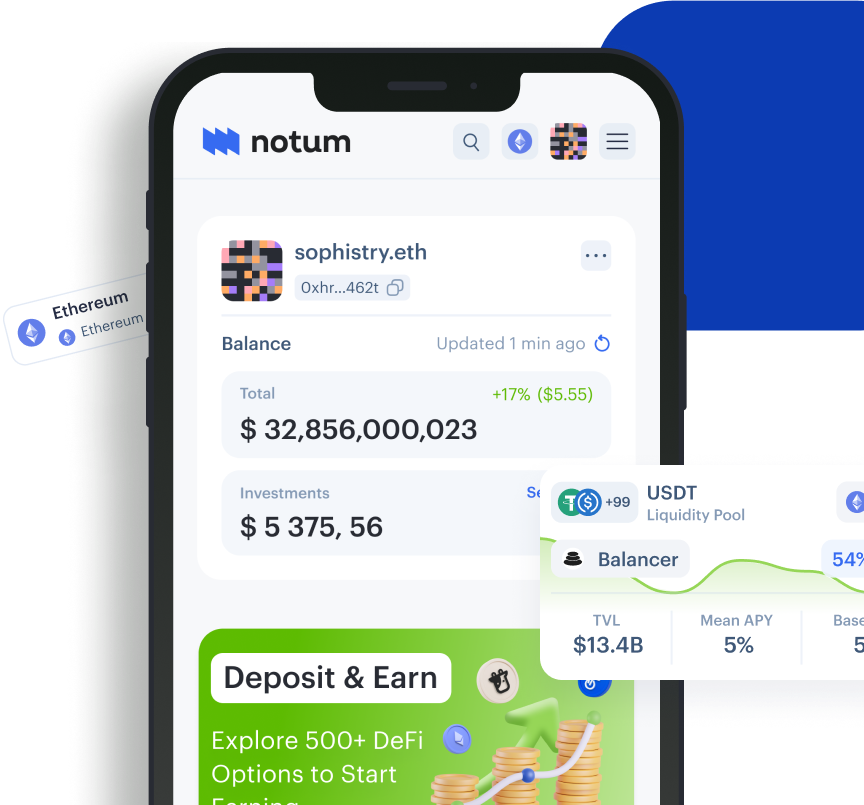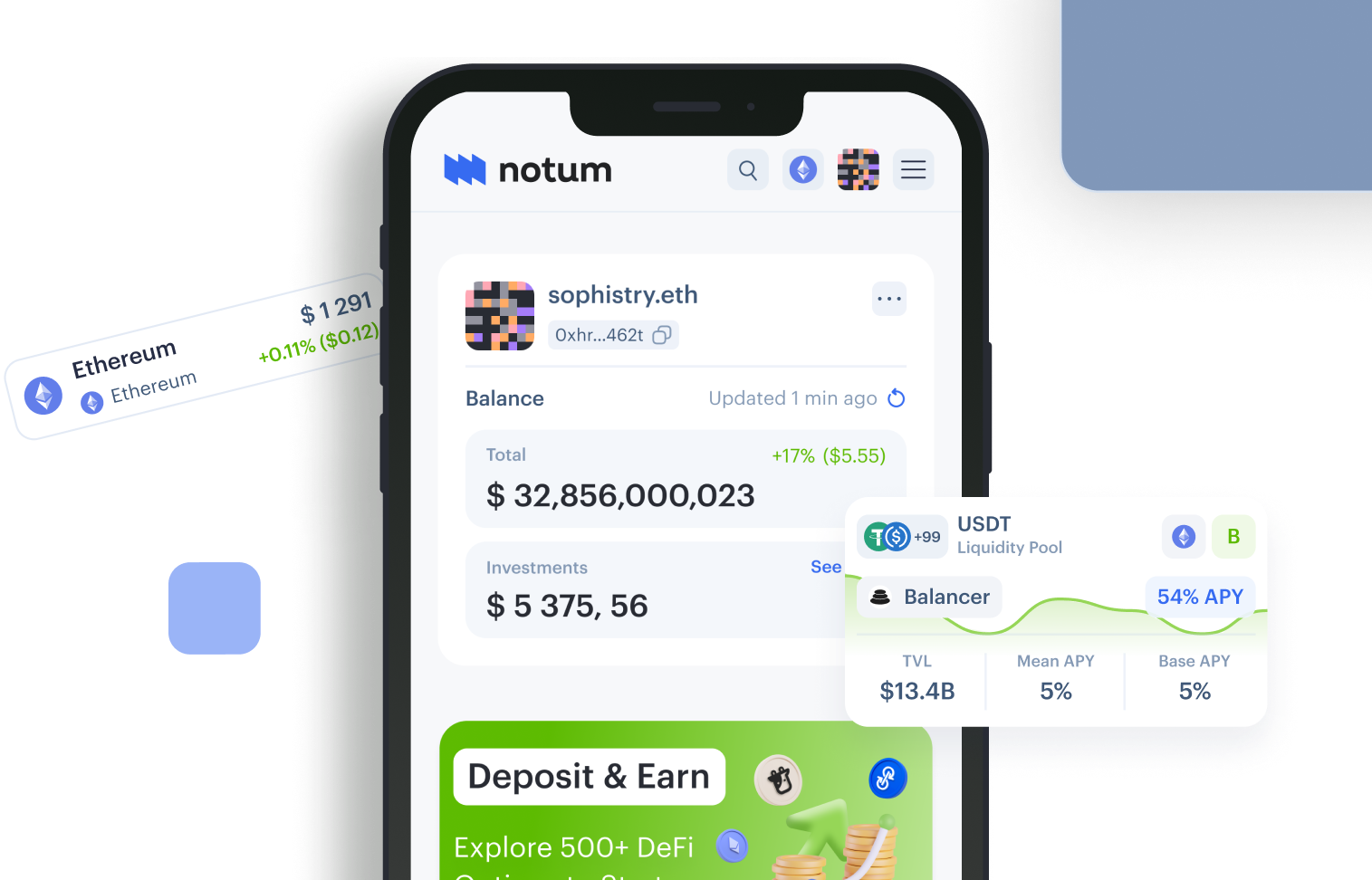Liquidity Pools Investments
Boost your yields by diving into liquidity pools.
Working with the best in industry

Stargate

Aerodrome

Curve

Velodrome V2

Trader Joe

Liquidity Pools in Numbers
$38B
Total TVL Across All Supported Networks
Low Risk
Generally considered as a low risk investment
Passive
Control-free. Hold & Earn.
111.21%
Average APY you can expect on Notum
How to Invest in Liquidity Pools on Notum
One of the cornerstones of DeFi is liquidity pool provision or liquidity pooling. In the scenario when an investor carefully assesses the possible risks and finds a well-structured strategy, it’s possible to gain a decent yield.
Liquidity pool provision is an investment strategy that has revolutionized the way trading and borrowing occur on various DeFi platforms. A liquidity pool is a collection of all funds deposited into a smart contract and is available for various operations, such as decentralized trading, financing, lending, etc.
Liquidity pools themselves are made up of funds contributed by users and help provide liquidity to various decentralized exchanges.
Both DeFi platforms and DEX exchanges use automated market makers (AMMs), that is, algorithms that use liquidity pools instead of actual market makers. Their main goal is to provide users with the opportunity to trade cryptocurrency freely and securely. AMMs, in turn, allow users to make deals with smart contracts and not with each other. This is why there is a need for stable and secure DeFi liquidity pools.
Crypto liquidity pools help users exchange one token for another without a trading partner. Instead of buying tokens at high prices from investors, they can be purchased at the market rate that is automatically set on the platform.
- Risk Level: Medium
- User Involvement: High
- Potential Returns: Variable, Potentially High
- Automated or not: Not Automated
- Potential Risks: Impermanent Loss, Market Volatility, Smart-Contract Risks, Protocol Changes
- Key Features: Earning trading fees
- Popular Platforms: Uniswap, Balancer, Stargate
How Do You Earn From Liquidity Pools?
As known, DeFi liquidity pools allow users to provide liquidity on crypto exchanges and decentralized financial platforms. User funds are combined into a pool, which consists of two assets, for example, Ethereum and USDT. Pool participants contribute both assets, which become liquidity for a given trading pair.
After providing liquidity to the pool, participants receive LP tokens (liquidity pool tokens) representing their share of the pool.
Commissions for trades completed in the liquidity pool go to pool participants. These rewards are distributed among liquidity providers in accordance with their share of total liquidity. In simple terms, participants receive commissions as a reward for providing liquidity.
The user's profit depends on several factors, such as trading volume, volatility of assets in the pool, price changes, etc.
The higher the trading volume and the more stable the price, the higher the reward for providing liquidity.
Why Invest in Liquidity Pool Provision?
Liquidity pools are undoubtedly one of the most important parts of the DeFi sector, as they allow users to do swaps. However, in addition to this, this investment strategy is a great opportunity to receive relatively high rewards. As you know, when providing liquidity, users receive LP tokens representing their share in the pool. The value of such tokens is equal to the number of assets provided, but they cannot be traded on crypto exchanges. However, LP tokens can be used for other purposes, such as exchange between users, staking, or yield farming.
Thus, investing in liquidity pools not only brings users a share of trading fees but also provides the opportunity to receive additional rewards from LP-tokens.
Liquidity pool provision is an investment strategy suitable for experienced users that requires a certain level of involvement and brings fairly high rewards compared to other strategies in the DeFi world. At the moment, the most popular protocols for liquidity pool provision are Balancer, Uniswap, Velodrome, and Stargate.
Pros
High rewards
Liquidity pool participants who provide their assets earn a portion of the transaction fees that occur in their pools. Thus, by providing liquidity, users receive a fairly high passive income.
Extra profit
In addition to receiving rewards with trading fees, pool participants can also use the received LP tokens to earn additional income.
Decentralization
Since liquidity pools are most often decentralized, this increases security and contributes to the development of the DeFi space.
Cons
Impermanent loss
Due to changes in the pool’s asset prices, users who provide liquidity may lose a part of the capital when withdrawing liquidity from the pool.
Security risks
In some cases, liquidity pools face security risks, such as mining attacks, protocol-level attacks, and such.
Market Volatility
During periods of high market volatility, users can experience some liquidity issues.
Liquidity Pool Provision with Balancer
Balancer is a decentralized AMM protocol based on Ethereum that encourages interaction between liquidity providers, traders, and pools to find the best price across multiple platforms.
- TVL: $829,010,000
- Risk Level: Low-Medium
- Blockchains: Ethereum Mainnet, Polygon, Arbitrum, Gnosis
- Foundation Date: 2018
Balancer uses smart contract-based algorithms to maintain the balance and desired ratio of assets in the liquidity pool. The protocol gives users the opportunity to not only trade tokens but also invest in liquidity pools, as well as create their own to profit from trades.
As of November 2023, the Balancer protocol has more than 103,000 liquidity providers and almost 6,000 total pools.
Investment Strategies on Balancer
https://app.notum.ai/investments/0x32df62dc3aed2cd6224193052ce665dc18165841?protocol=Balancer+V2&chainId=42161
The RDNT-WETH pool consists of 80% RDNT and 20% WETH. By providing their assets to this liquidity pool, users can receive a reward of 10.81% - 15.33% APR.
https://app.notum.ai/investments/0xb3028ca124b80cfe6e9ca57b70ef2f0ccc41ebd4?protocol=Balancer+V2&chainId=42161
The MAGIC-USDC pool consists of 50% RDNT and 50% WETH. By providing their assets to this liquidity pool, users can receive a reward of 24.71% - 38.87% APR.
Pros
Automated portfolio management
Balancer allows users to create and manage liquidity pools with multiple tokens and different weights (for example, RDNT-WETH pool with 80% RDNT and 20% WETH).
Liquidity provision
The protocol offers enough flexibility for liquidity providers to deposit their assets.
Decentralized structure
Balancer runs on the Ethereum blockchain, it is decentralized and secure like the platform itself.
Cons
Impermanent loss
liquidity providers may experience impermanent losses, resulting in lower returns compared to simply holding tokens.
Protocol complexity
Newcomers unfamiliar with DeFi concepts may be intimidated by the protocol's more advanced user-oriented flexibility.
Smart contracts risks
Balancer, like all other DeFi protocols, faces smart contract risks.
Why Invest in Balancer?
Balancer is a medium-risk decentralized finance protocol that offers a huge number of liquidity pools, supported blockchains, and high rewards for providing liquidity.
Liquidity providers receive trading commissions from users trading through Balancer pools, which stimulates users to contribute liquidity.
Liquidity Pool Provision with Stargate
Stargate is a relatively new revolutionary liquidity transport protocol, the distinctive feature of which is complete composability. This protocol also underlies Omnichain DeFi.
- TVL: $353,520,000
- Risk Level: Low-Medium
- Blockchains: Ethereum, Polygon, Avalanche, BSC, Fantom, Optimism and Arbitrum
- Foundation Date: 2022
Stargate operates using unified liquidity pools between chains and is famous for its guaranteed transaction completion. Also, the protocol allows users and decentralized applications to transfer native assets cross-chain. In addition to this, they simultaneously gain access to Stargate’s unified liquidity pools.
With Stargate, users can take advantage of several investment strategies - farming, staking, and liquidity provision.
Investment Strategies on Stargate
https://app.notum.ai/investments/0x1205f31718499dbf1fca446663b532ef87481fe1?protocol=Stargate&chainId=43114
This liquidity pool provides users with the opportunity to receive stablecoin rewards on the Avalanche network. For providing liquidity in the USDC pool, users can receive up to 11.5% APR.
https://app.notum.ai/investments/0xdf0770df86a8034b3efef0a1bb3c889b8332ff56?protocol=Stargate&chainId=1
Adding liquidity to Stargate's Ethereum USDC pool, users also receive stablecoins as a reward for every Stargate transfer. Potential APRs for providing liquidity to this pool range from 5% to 8%.
Pros
Unified liquidity pools
Stargate uses unified liquidity pools shared between chains, this gives the user guaranteed finality.
Ease of use
Due to the lack of wrapped tokens and a clear user-friendly interface, the protocol is quite easy to use.
No impermanent loss
Stargate liquidity pools consist of stablecoins, which significantly reduces risk since they are less volatile compared to other assets.
Cons
Smart contract exploits
Like any other protocol on the market, Stargate is also not immune to the risk of smart contracts.
Security concerns
The risk of vulnerabilities still exists.
Lack of a strong reputation
Since the protocol has been around relatively recently (since 2022), there is no clarity yet regarding its long-term prospects as it has shown unsustainable high returns.
Why Invest in Stargate?
Stargate is a medium-risk liquidity transport protocol that offers a large number of liquidity pools for staking stablecoins on seven different blockchains. Ease of use and relatively high rewards make Stargate one of the best protocols to invest in in 2023.
In addition to receiving rewards for providing liquidity, Stargate protocol users can also farm received LP tokens to get additional STG token rewards.
Boost Your Passive Income
Choose from a wide range of investments on Notum. Compare. Make a move.
Get started


FAQ
1.
What are liquidity pool provision potential returns?
Potential returns from liquidity pool provision may vary depending on the asset, pool, chosen platform, and market conditions. Typically, users receive an APR of 10% to 30%.
2.
Can liquidity pool provision be automated?
Smart contracts enable the creation of decentralized protocols that automatically manage the deposit, withdrawal, and pricing of assets in liquidity pools. However, the user still must select assets, platforms, and pools, and assess risks before providing liquidity.
3.
What are liquidity pool provision risks?
The main risks of liquidity pool provision include impermanent loss, market volatility, smart contract risks, and protocol changes.
4.
What is a liquidity pool?
A crypto liquidity pool is a combination of coins or tokens on a smart contract that can be used for financing, decentralized trading, lending, and other transactions.
5.
What is a liquidity provider?
A liquidity provider (LP) is a company or person that provides liquidity to liquidity pools or decentralized exchanges. Typically, LPs provide a pair of assets in a smart contract to receive rewards.
6.
How do liquidity pools work?
Users contribute their assets to liquidity pools to create liquidity. In return, they receive rewards and tokens representing their share of the pool, which enables them to execute transactions on various blockchain platforms.